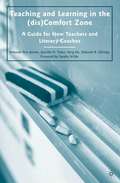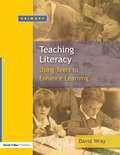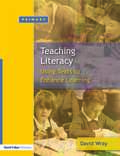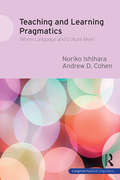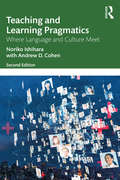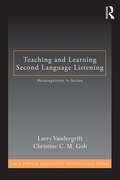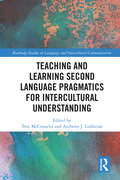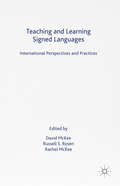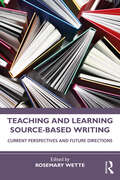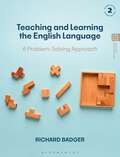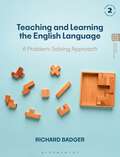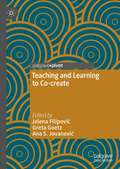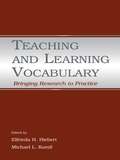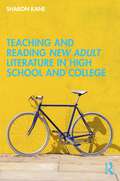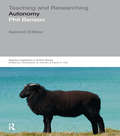- Table View
- List View
Teaching and Learning in the (dis)Comfort Zone: A Guide for New Teachers and Literacy Coaches
by D. Jensen D. Eldridge Y. Hu J. TutenThe novice teacher and literacy coach need to form a team to share their expertise and continually evolve, to have opportunity for guided reflection and self-assessment of practice. This book shares these professional experiences which delineates and describes the (dis)comfort of teaching and learning at the edge of the teachers' comfort zone.
Teaching and Learning Literacy: Reading and Writing Texts for a Purpose
by David WrayDavid Wray offers a range of practical suggestions for enhancing literacy work in primary and secondary schools (KS 1-3). The book is based on the idea that the purpose of literacy teaching is to enable pupils to understand and create meaningful, whole texts. It deliberately takes a cross-curricular view of literacy and will appeal to teachers who specialize in a range of subjects. It also explores in-depth the processes involved in both understanding and composing a range of text types, avoiding the temptation to segment literacy skills, thereby losing sight of the overall purpose. The book is aimed at primary teachers and student teachers with an interest in extending their pupils' experiences of texts across the curriculum; and at secondary teachers (especially English teachers) who wish to include in their subject teaching more explicit attention to their pupils' literacy skills.
Teaching and Learning Literacy: Reading and Writing Texts for a Purpose
by David WrayDavid Wray offers a range of practical suggestions for enhancing literacy work in primary and secondary schools (KS 1-3). The book is based on the idea that the purpose of literacy teaching is to enable pupils to understand and create meaningful, whole texts. It deliberately takes a cross-curricular view of literacy and will appeal to teachers who specialize in a range of subjects. It also explores in-depth the processes involved in both understanding and composing a range of text types, avoiding the temptation to segment literacy skills, thereby losing sight of the overall purpose. The book is aimed at primary teachers and student teachers with an interest in extending their pupils' experiences of texts across the curriculum; and at secondary teachers (especially English teachers) who wish to include in their subject teaching more explicit attention to their pupils' literacy skills.
Teaching and Learning Pragmatics: Where Language and Culture Meet
by Noriko Ishihara Andrew D. CohenAn understanding of sociocultural context is crucial in second language learning - yet developing this awareness often poses a real challenge to the typical language learner. This book is a practical language teachers' guide that focuses on how to teach socially and culturally appropriate language for effective communication. Moving beyond a purely theoretical approach to pragmatics, the volume offers practical advice to teachers, with hands-on classroom tasks included in every chapter. Readers will be able to: · Identify possible causes of learner errors and choices in cross-cultural communication· Understand second language acquisition theories that support their classroom practices· Develop a pragmatics-focused instructional component, classroom-based assessments, and curricula · Help learners to become more strategic about their learning and performance of speech acts· Incorporate technology into their approach to teaching pragmaticsThis book aims to close the gap between what research in pragmatics has found and how language is generally taught today. It will be of interest to all language teachers, graduate students in language teaching and linguistics, teacher educators, and developers of materials for teaching language.
Teaching and Learning Pragmatics: Where Language and Culture Meet
by Noriko Ishihara Andrew D. CohenAn understanding of sociocultural context is crucial in second language learning - yet developing this awareness often poses a real challenge to the typical language learner. This book is a practical language teachers' guide that focuses on how to teach socially and culturally appropriate language for effective communication. Moving beyond a purely theoretical approach to pragmatics, the volume offers practical advice to teachers, with hands-on classroom tasks included in every chapter. Readers will be able to: · Identify possible causes of learner errors and choices in cross-cultural communication· Understand second language acquisition theories that support their classroom practices· Develop a pragmatics-focused instructional component, classroom-based assessments, and curricula · Help learners to become more strategic about their learning and performance of speech acts· Incorporate technology into their approach to teaching pragmaticsThis book aims to close the gap between what research in pragmatics has found and how language is generally taught today. It will be of interest to all language teachers, graduate students in language teaching and linguistics, teacher educators, and developers of materials for teaching language.
Teaching and Learning Pragmatics: Where Language and Culture Meet
by Noriko Ishihara Andrew D. CohenAn understanding of sociocultural context is crucial in second language learning–yet developing this awareness often poses a real challenge to the typical language learner. This book is a language teachers’ guide that focuses on how to teach socially and culturally preferred language for effective intercultural communication. Moving beyond a purely theoretical approach to pragmatics, the volume offers practical advice to teachers, with hands-on classroom tasks included in every chapter. Readers will be able to: · Understand the link between language use, linguacultural diversity, and multilingual identity · Identify possible causes of learner errors and choices in intercultural communication · Understand applied linguistics theories that support culturally sensitive classroom practices · Develop a pragmatics-focused instructional component, classroom-based assessments, and curricula · Help learners to become more strategic about their learning and performance of speech acts · Incorporate technology into their approach to teaching pragmatics This book aims to close the gap between what research in pragmatics has found and how language is generally taught today. It will be of interest to all language teachers, graduate students in language teaching and linguistics, teacher educators, and developers of materials for teaching language.
Teaching and Learning Pragmatics: Where Language and Culture Meet
by Noriko Ishihara Andrew D. CohenAn understanding of sociocultural context is crucial in second language learning–yet developing this awareness often poses a real challenge to the typical language learner. This book is a language teachers’ guide that focuses on how to teach socially and culturally preferred language for effective intercultural communication. Moving beyond a purely theoretical approach to pragmatics, the volume offers practical advice to teachers, with hands-on classroom tasks included in every chapter. Readers will be able to: · Understand the link between language use, linguacultural diversity, and multilingual identity · Identify possible causes of learner errors and choices in intercultural communication · Understand applied linguistics theories that support culturally sensitive classroom practices · Develop a pragmatics-focused instructional component, classroom-based assessments, and curricula · Help learners to become more strategic about their learning and performance of speech acts · Incorporate technology into their approach to teaching pragmatics This book aims to close the gap between what research in pragmatics has found and how language is generally taught today. It will be of interest to all language teachers, graduate students in language teaching and linguistics, teacher educators, and developers of materials for teaching language.
Teaching and Learning Second Language Listening: Metacognition in Action (ESL & Applied Linguistics Professional Series)
by Larry Vandergrift Christine C.M. GohThis reader-friendly text, firmly grounded in listening theories and supported by recent research findings, offers a comprehensive treatment of concepts and knowledge related to teaching second language (L2) listening, with a particular emphasis on metacognition. The metacognitive approach, aimed at developing learner listening in a holistic manner, is unique and groundbreaking. The book is focused on the language learner throughout; all theoretical perspectives, research insights, and pedagogical principles in the book are presented and discussed in relation to the learner. The pedagogical model?a combination of the tried-and-tested sequence of listening lessons and activities that show learners how to activate processes of skilled listeners ? provides teachers with a sound framework for students’ L2 listening development to take place inside and outside the classroom. The text includes many practical ideas for listening tasks that have been used successfully in various language learning contexts.
Teaching and Learning Second Language Listening: Metacognition in Action (ESL & Applied Linguistics Professional Series)
by Larry Vandergrift Christine C.M. GohThis reader-friendly text, firmly grounded in listening theories and supported by recent research findings, offers a comprehensive treatment of concepts and knowledge related to teaching second language (L2) listening, with a particular emphasis on metacognition. The metacognitive approach, aimed at developing learner listening in a holistic manner, is unique and groundbreaking. The book is focused on the language learner throughout; all theoretical perspectives, research insights, and pedagogical principles in the book are presented and discussed in relation to the learner. The pedagogical model─a combination of the tried-and-tested sequence of listening lessons and activities that show learners how to activate processes of skilled listeners ─ provides teachers with a sound framework for students’ L2 listening development to take place inside and outside the classroom. The text includes many practical ideas for listening tasks that have been used successfully in various language learning contexts.
Teaching and Learning Second Language Pragmatics for Intercultural Understanding (Routledge Studies in Language and Intercultural Communication)
by Troy McConachy Anthony J. LiddicoatThis collection argues for the need to promote intercultural understanding as a clear goal for teaching and learning pragmatics in second and foreign language education. The volume sees the learning of pragmatics as a challenging yet enriching process whereby the individual expands their capacity for understanding how meaning making processes influence social relationships and how assumptions about social relationships shape the interpretation and use of language in context. This locates pragmatics within a humanistically oriented conception of learning where success is defined relative to the enrichment of human understanding and appreciation of difference. The book argues that intercultural understanding is not an “add on” to language learning but central to the learner’s ability to understand and construct meaning with individuals from diverse linguistic and cultural backgrounds. Chapters analyse teachers’ and learners’ ways of making sense of pragmatics, how their assumptions about social relationships impact their perceptions of language use, and how reflection on pragmatic judgments opens up possibilities for developing intercultural understanding. This book will be of interest to students and scholars in intercultural communication, language education, and applied linguistics.
Teaching and Learning Second Language Pragmatics for Intercultural Understanding (Routledge Studies in Language and Intercultural Communication)
by Troy McConachy Anthony J. LiddicoatThis collection argues for the need to promote intercultural understanding as a clear goal for teaching and learning pragmatics in second and foreign language education. The volume sees the learning of pragmatics as a challenging yet enriching process whereby the individual expands their capacity for understanding how meaning making processes influence social relationships and how assumptions about social relationships shape the interpretation and use of language in context. This locates pragmatics within a humanistically oriented conception of learning where success is defined relative to the enrichment of human understanding and appreciation of difference. The book argues that intercultural understanding is not an “add on” to language learning but central to the learner’s ability to understand and construct meaning with individuals from diverse linguistic and cultural backgrounds. Chapters analyse teachers’ and learners’ ways of making sense of pragmatics, how their assumptions about social relationships impact their perceptions of language use, and how reflection on pragmatic judgments opens up possibilities for developing intercultural understanding. This book will be of interest to students and scholars in intercultural communication, language education, and applied linguistics.
Teaching and Learning Signed Languages: International Perspectives and Practices
by Russell S. Rosen David McKee Rachel McKeeTeaching and Learning Signed Languages examines current practices, contexts, and the research nexus in the teaching and learning of signed languages, offering a contemporary, international survey of innovations in this field.
Teaching and Learning Source-Based Writing: Current Perspectives and Future Directions
by Rosemary WetteThis volume brings together significant findings, approaches, and research-based pedagogies on teaching and learning source-based writing. A comprehensive update to the field, this book presents source-based writing as an essential skill that comes with its own specific set of challenges, requiring a complex set of literacy skills and capabilities for mastery. With contributors from leading scholars from around the world, the volume addresses source-based writing as a developmental issue and offers guidance for supporting novice academic writers on their path toward proficiency and accumulation of multifaceted skill set. Chapters cover key topics, including metacognitive skills, the flipped classroom, scaffolding, assessment, and ethical considerations. With research reviews, practical considerations and future directions as components of each chapter, this book is ideal for courses on academic writing and second language writing.
Teaching and Learning Source-Based Writing: Current Perspectives and Future Directions
This volume brings together significant findings, approaches, and research-based pedagogies on teaching and learning source-based writing. A comprehensive update to the field, this book presents source-based writing as an essential skill that comes with its own specific set of challenges, requiring a complex set of literacy skills and capabilities for mastery. With contributors from leading scholars from around the world, the volume addresses source-based writing as a developmental issue and offers guidance for supporting novice academic writers on their path toward proficiency and accumulation of multifaceted skill set. Chapters cover key topics, including metacognitive skills, the flipped classroom, scaffolding, assessment, and ethical considerations. With research reviews, practical considerations and future directions as components of each chapter, this book is ideal for courses on academic writing and second language writing.
Teaching and Learning the English Language: A Problem-Solving Approach
by Dr Richard BadgerOffering a solid, research-based approach along with sound practical advice, this book equips you with the skills you need to analyse your own contexts and develop your practice, whether through formal study or alone. Badger explores teaching English as a problem-solving activity addressing three fundamental questions: what aspect of language do students needs to learn, how do they learn it, and how can teachers support this learning. This new edition includes updated references, a chapter on pragmatics, coverage of concepts such as translanguaging, CLIL, EMI, English as a lingua franca and sections on digital learning. Topics covered include: · Psychological and social learning processes · TESOL teaching methods and approaches · Lesson planning and classroom management · English teacher professional development The book also includes chapter summaries, activities for students and key readings recommendations, and online resources such as video case studies, additional exercises and multiple choice quizzes to consolidate learning. The book is ideal for both trainee and practicing teachers who want to develop their practice.
Teaching and Learning the English Language: A Problem-Solving Approach
by Dr Richard BadgerOffering a solid, research-based approach along with sound practical advice, this book equips you with the skills you need to analyse your own contexts and develop your practice, whether through formal study or alone. Badger explores teaching English as a problem-solving activity addressing three fundamental questions: what aspect of language do students needs to learn, how do they learn it, and how can teachers support this learning. This new edition includes updated references, a chapter on pragmatics, coverage of concepts such as translanguaging, CLIL, EMI, English as a lingua franca and sections on digital learning. Topics covered include: · Psychological and social learning processes · TESOL teaching methods and approaches · Lesson planning and classroom management · English teacher professional development The book also includes chapter summaries, activities for students and key readings recommendations, and online resources such as video case studies, additional exercises and multiple choice quizzes to consolidate learning. The book is ideal for both trainee and practicing teachers who want to develop their practice.
Teaching and Learning to Co-create
by Jelena Filipović Greta Goetz Ana S. JovanovićThis edited book approaches the learning experience as a creative, constructive process from an epistemological orientation that combines transdisciplinary, participatory, and collaborative approaches to explore the most constructive ways forward for a networked constructivist (project- and problem-based) pedagogy. The volume emphasizes the value of a number of modes of inquiry that, among others, include ethnography, auto-ethnography, corpus analysis, narrative analysis, and their many intersections in the process of academic maturation and growth. This book will be of interest to applied linguists, sociolinguists, researchers, and educators of topics related to higher education and academic maturation, networked learning, qualitative inquiry and transdisciplinary studies.
Teaching and Learning Vocabulary: Bringing Research to Practice
by Elfrieda H. Hiebert Michael L. KamilAlthough proficiency in vocabulary has long been recognized as basic to reading proficiency, there has been a paucity of research on vocabulary teaching and learning over the last two decades. Recognizing this, the U.S. Department of Education recently sponsored a Focus on Vocabulary conference that attracted the best-known and most active researchers in the vocabulary field. This book is the outgrowth of that conference. It presents scientific evidence from leading research programs that address persistent issues regarding the role of vocabulary in text comprehension. Part I examines how vocabulary is learned; Part II presents instructional interventions that enhance vocabulary; and Part III looks at which words to choose for vocabulary instruction.Other key features of this timely new book include:*Broad Coverage. The book addresses the full range of students populating current classrooms--young children, English Language Learners, and young adolescents.*Issues Focus. By focusing on persistent issues from the perspective of critical school populations, this volume provides a rich, scientific foundation for effective vocabulary instruction and policy.*Author Expertise. Few volumes can boast of a more luminous cast of contributing authors (see table of contents).This book is suitable for anyone (graduate students, in-service reading specialists and curriculum directors, college faculty, and researchers) who deals with vocabulary learning and instruction as a vital component of reading proficiency.
Teaching and Learning Vocabulary: Bringing Research to Practice
by Elfrieda H. Hiebert Michael L. KamilAlthough proficiency in vocabulary has long been recognized as basic to reading proficiency, there has been a paucity of research on vocabulary teaching and learning over the last two decades. Recognizing this, the U.S. Department of Education recently sponsored a Focus on Vocabulary conference that attracted the best-known and most active researchers in the vocabulary field. This book is the outgrowth of that conference. It presents scientific evidence from leading research programs that address persistent issues regarding the role of vocabulary in text comprehension. Part I examines how vocabulary is learned; Part II presents instructional interventions that enhance vocabulary; and Part III looks at which words to choose for vocabulary instruction.Other key features of this timely new book include:*Broad Coverage. The book addresses the full range of students populating current classrooms--young children, English Language Learners, and young adolescents.*Issues Focus. By focusing on persistent issues from the perspective of critical school populations, this volume provides a rich, scientific foundation for effective vocabulary instruction and policy.*Author Expertise. Few volumes can boast of a more luminous cast of contributing authors (see table of contents).This book is suitable for anyone (graduate students, in-service reading specialists and curriculum directors, college faculty, and researchers) who deals with vocabulary learning and instruction as a vital component of reading proficiency.
Teaching and Reading New Adult Literature in High School and College
by Sharon KaneAn introduction to the rapidly growing category of New Adult (NA) literature, this text provides a roadmap to understanding and introducing NA books to young people in high school, college, libraries, and other settings. As a window into the experiences and unique challenges that young and new adults encounter, New Adult literature intersects with but is distinct from Young Adult literature. This rich resource provides a framework, methods, and plentiful reading recommendations by genre, theme, and discipline on New Adult literature. Starting with a definition of New Adult literature, Kane demonstrates how the inclusion of NA literature helps support and encourage a love of reading. Chapters address important topics that are relevant to young people, including post-high school life, early careers, relationships, activism, and social change. Each chapter features text sets, instructional strategies, writing prompts, and activities to invite and encourage young people to be reflective and engaged in responding to thought-provoking texts. A welcome text for professors of literacy and literature instruction, first-year college instructors, researchers, librarians, and educators, this book provides new ways to assist students as they embark upon the next stage of their lives and is essential reading for courses on teaching literature.
Teaching and Reading New Adult Literature in High School and College
by Sharon KaneAn introduction to the rapidly growing category of New Adult (NA) literature, this text provides a roadmap to understanding and introducing NA books to young people in high school, college, libraries, and other settings. As a window into the experiences and unique challenges that young and new adults encounter, New Adult literature intersects with but is distinct from Young Adult literature. This rich resource provides a framework, methods, and plentiful reading recommendations by genre, theme, and discipline on New Adult literature. Starting with a definition of New Adult literature, Kane demonstrates how the inclusion of NA literature helps support and encourage a love of reading. Chapters address important topics that are relevant to young people, including post-high school life, early careers, relationships, activism, and social change. Each chapter features text sets, instructional strategies, writing prompts, and activities to invite and encourage young people to be reflective and engaged in responding to thought-provoking texts. A welcome text for professors of literacy and literature instruction, first-year college instructors, researchers, librarians, and educators, this book provides new ways to assist students as they embark upon the next stage of their lives and is essential reading for courses on teaching literature.
Teaching and Researching: Autonomy in Language Learning
by Phil BensonAutonomy has become a keyword of language policy in education systems around the world, as the importance of independent learning and new technologies has grown. Now in a fully revised and updated second edition, Teaching and Researching Autonomy provides an accessible and comprehensive critical account of the theory and practice of autonomy. Examining the history of the concept, it addresses important questions of how we can identify autonomy in language learning behaviours and how we can evaluate the wide variety of educational practices that have been designed to foster autonomy in learning. Topics new to this edition include: - Autonomy and new technologies - Teacher autonomy - The sociocultural implications of autonomy With over three hundred new references and five new case studies of research on autonomy providing practical advice on research methods and topics in the field, Teaching and Researching Autonomy will be an essential introduction for teachers and students to a subject at the cutting edge of language teaching and research.
Teaching and Researching: Autonomy in Language Learning
by Phil BensonAutonomy has become a keyword of language policy in education systems around the world, as the importance of independent learning and new technologies has grown. Now in a fully revised and updated second edition, Teaching and Researching Autonomy provides an accessible and comprehensive critical account of the theory and practice of autonomy. Examining the history of the concept, it addresses important questions of how we can identify autonomy in language learning behaviours and how we can evaluate the wide variety of educational practices that have been designed to foster autonomy in learning. Topics new to this edition include: - Autonomy and new technologies - Teacher autonomy - The sociocultural implications of autonomy With over three hundred new references and five new case studies of research on autonomy providing practical advice on research methods and topics in the field, Teaching and Researching Autonomy will be an essential introduction for teachers and students to a subject at the cutting edge of language teaching and research.
Teaching and Researching: Motivation (PDF)
by Zoltán Dörnyei Ema UshiodaCultivating motivation is crucial to a language learner's success - and therefore crucial for the language teacher and researcher to understand. This fully revised edition of a groundbreaking work reflects the dramatic changes the field of motivation research has undergone in recent years, including the impact of language globalisation and various dynamic and relational research methodologies, and offers ways in which this research can be put to practical use in the classroom and in research. Key new features and material: A brand new chapter on current socio-dynamic and complex systems perspectives New approaches to motivating students based on the L2 Motivational Self System Illustrative summaries of qualitative and mixed methods studies Samples of new self-related motivation measures Providing a clear and comprehensive theory-driven account of motivation, Teaching and Researching Motivation examines how theoretical insights can be used in everyday teaching practice, and offers practical tips. The final section provides a range of useful resources, including relevant websites, key reference works and tried and tested example questionnaires. Written in an accessible style and illustrated with concrete examples, itis an invaluable resource for teachers and researchers alike. 9781408205129
Teaching and Researching: Motivation
by Zoltán Dörnyei Ema UshiodaCultivating motivation is crucial to a language learner's success - and therefore crucial for the language teacher and researcher to understand. This fully revised edition of a groundbreaking work reflects the dramatic changes the field of motivation research has undergone in recent years, including the impact of language globalisation and various dynamic and relational research methodologies, and offers ways in which this research can be put to practical use in the classroom and in research. Key new features and material: A brand new chapter on current socio-dynamic and complex systems perspectives New approaches to motivating students based on the L2 Motivational Self System Illustrative summaries of qualitative and mixed methods studies Samples of new self-related motivation measures Providing a clear and comprehensive theory-driven account of motivation, Teaching and Researching Motivation examines how theoretical insights can be used in everyday teaching practice, and offers practical tips. The final section provides a range of useful resources, including relevant websites, key reference works and tried and tested example questionnaires. Written in an accessible style and illustrated with concrete examples, itis an invaluable resource for teachers and researchers alike. 9781408205129
